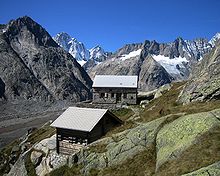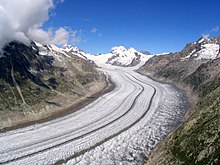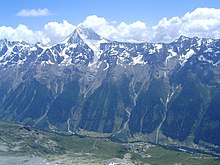Swiss Alps Jungfrau-Aletsch
Swiss Alps Jungfrau-Aletsch is an 824 km² UNESCO World Heritage Site in the Bernese Alps in Switzerland . The area lies in the cantons of Bern and Valais .
area
The Swiss Alps Jungfrau-Aletsch World Heritage area begins in the north at the foot of the famous Bernese Oberland mountains, the Eiger , Mönch and Jungfrau . In the center is the Aletsch area with the Aletsch Glacier . To the east, the “perimeter” extends to the Lauteraarhorn , the Finsteraarhorn ( the highest point at 4273 m above sea level ), the Oberaarhorn and the Grimsel Pass . In the west, parts of the Kandertal and Lötschental , the Blüemlisalp group, the Bietschhorn and several valleys on its south side belong to it.
This part of the Bernese Alps is the habitat of many rare animal and plant species ( alpine ibex , western green lizard ), but could also serve as a place for reintroduction projects in the wild for animals no longer to be found such as the bearded vulture .
In the canton of Bern:
|
In the canton of Valais:
|
history
Swiss Alps Jungfrau-Aletsch is a new creation of the IG World Natural Heritage , which amalgamated various unique cultural and natural heritage sites. The basis is the “Charter from Konkordiaplatz”, in which 15 municipalities committed themselves to sustainable development within the region and sought to be recognized by UNESCO . On June 28, 2000, the Swiss Federal Council applied for inclusion in the UNESCO World Heritage List. This was granted on December 13, 2001 and Jungfrau-Aletsch-Bietschhorn became the first natural heritage of the Alpine region . Andrea Cova, a hotelier from Wengen , who fought for this idea for years, is considered to be the real driving force behind this concern . He did not live to see the implementation; he died on February 29, 2000.
In 2007 the UNESCO expanded the area to the west ( Blüemlisalp ) and east ( Aargletscher , Grimsel ) by 285 square kilometers. Until then, the world heritage site was called Jungfrau-Aletsch-Bietschhorn . Eleven other municipalities were involved - the number of all municipalities with a share in the perimeter has since decreased again due to municipal mergers.
Attractions
Virgo area
- Impressive mountain landscape of the Eiger , Mönch and Jungfrau
- Jungfraujoch with the highest railway station in Europe at 3454 m above sea level. M.
- Trümmelbach Falls
Grimsel area
Aletsch area
- Great Aletsch Glacier (23 km longest glacier in the Alps)
- Untouched high mountain landscape with numerous glaciers
- Aletsch forest in the glacier foreland with the oldest tree in Switzerland
Bietschhorn area
Blüemlisalp area
literature
- Adolf Ogi (President of the Foundation's Patronage Committee): “UNESCO World Heritage Swiss Alps Jungfrau-Aletsch”. In: Alpine tours in the Bernese Alps 4. Jungfrau Region Tschingelhorn / Eiger / Fiescherhörner / Finsteraarhorn . Bern, SAC Verlag, 2010, ISBN 978-3-85902-308-6 .
Web links
- Entry in the UNESCO World Heritage List ( English , French )
- UNESCO World Natural Heritage Swiss Alps Jungfrau-Aletsch
- Video impressions of a ski tour (Lötschentour) through the UNESCO World Natural Heritage Swiss Alps Jungfrau-Aletsch
Individual evidence
- ↑ Unesco World Heritage plaque for Andrea Cova. April 13, 2006, accessed July 11, 2014 .







